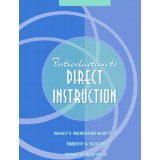If you are interested in making sure that all kids get a great education, you may like spending some time learning about scientifically-designed academic programs at the website of the National Institute for Direct Instruction.
 Direct Instruction
Direct Instruction
Direct Instruction is not yet a household name, but it deserves to be. Direct Instruction (DI) is a body of academic programs for teaching reading, writing, spelling, mathematics, language, American history and science. DI programs have 40+ years of research validation demonstrating that they result in superior learning outcomes for all students. The commitment to teach all students, regardless of socio-economic or educational levels, is the basic assumption of Direct Instruction.
The Direct Instruction philosophy states:
- All children can be taught.
- All children can improve academically and in terms of self image.
- All teachers can succeed if provided with adequate training and materials.
- Low performers and disadvantaged learners must be taught at a faster rate than typically occurs if they are to catch up to their higher-performing peers.
- All details of instruction must be controlled to minimize the chance of students’ misinterpreting the information being taught and to maximize the reinforcing effect of instruction.
Clear Teaching
If you would like to learn more about Direct Instruction, please see the book Clear Teaching (free download available). The National Institute for Direct Instruction explains: “Written by veteran journalist Shepard Barbash over a period of 10 years, Clear Teaching is a well-researched, highly readable introduction to Direct Instruction (DI), a systematic teaching approach which for more than 40 years has dramatically improved learning outcomes for students of all abilities and from all walks of life.
The book looks at the development of DI through the early experiences of its creator, Zig Engelmann; explains the principles that underpin this approach; and looks at DI’s reception in the world of teaching, where it has been effectively shunned despite a formidable research base and example after example of transformative success.”
Direct Instruction programs are highly compatible with TAGteach. The lessons are broken down into small steps, and it easy to tag and reinforce the child’s correct responses. For example, in a reading lesson the instructor points to the letter M and says, “This sound is ‘mmmm’. Say ‘mmmm’.” When the child says “mmmm,” tag and reinforce. It’s as simple as that.
The huge benefit of TAGteach is that the extremely precise reinforcement of the correct response lets the child know–right away–that he/she was right, so the child experiences the thrill of in-the-moment immediate success! Direct Instruction programs are designed with hundreds of opportunities for correct responding within each lesson, so the child has hundreds of opportunities to experience success. Children who experience lots success are eager to keep going; they want to learn more and try more. With TAGteach it is easy to reinforce correct academic behaviors as well as desirable social behaviors.
What is TAGteach?
TAGteach stands for Teaching with Acoustical Guidance. TAGteach is a teaching and communication method based on the scientific principles of Applied Behavior Analysis (ABA).
TAGteach enables extremely precise positive reinforcement of behavior by using an acoustical signal to “mark” a behavior – at the precise moment the child performs the behavior! The acoustical signal is a short, sharp sound made by a handheld device (the “tagger”). When the child performs the correct action, the parent/instructor immediately presses the button on the tagger and hands over a treat (candy, treat, token, praise, social recognition, or money) as a reinforcer.
With TAGteach, it is easy to reinforce behaviors precisely, quickly, and intensively. The immediate, accurate feedback and positive reinforcement result in the child performing the correct action more often, and for longer periods of time. With immediate feedback and learning tasks broken down into small steps, children (and adults) can learn many new skills with TAGteach — at their own pace.
TAGteach Resources:
To learn more about this effective, low-cost method visit TAGteach International or Chaos to Calm
For research on TAGteach, please see the TAGteach Reference List
- See the Free Video Series on TAGteach for Autism: https://tagteachblog.com/martha-parent-video-series/
- Take the Free TAGteach Fundamentals On-Line Course: https://tagteach.com/Free-TAGteach-course
- Join the free TAGteach for Learning, Behavior, and Autism Facebook group
- TAGteach taggers available here and i-Clicks available here
- See Martha’s book about TAGteach for Autism or feel free to ask me a question (with no obligation).
- Sign up for my mailing list to receive updates, new articles and free tips right in your inbox!
If you liked this post, please share it. Thank you!
